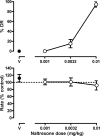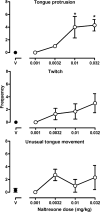Antagonist-precipitated and discontinuation-induced withdrawal in morphine-dependent rhesus monkeys
- PMID: 18726088
- PMCID: PMC3449323
- DOI: 10.1007/s00213-008-1293-6
Antagonist-precipitated and discontinuation-induced withdrawal in morphine-dependent rhesus monkeys
Abstract
Rationale: Upon discontinuation of chronic opioid treatment, withdrawal typically peaks in 1-3 days and decreases markedly within 1 week; however, persistent physiological changes have been reported long after other signs have waned.
Objective: The goal of this study was to compare the discriminative stimulus, directly observable signs, and physiological effects of withdrawal in morphine-treated monkeys.
Materials and methods: Monkeys received 5.6 mg/kg/12 h morphine and discriminated 0.0178 mg/kg naltrexone while responding under a fixed-ratio 5 schedule of stimulus-shock termination. Drug discrimination, behavioral observation, and telemetry were used to monitor the emergence of withdrawal, as well as any persistent changes, following discontinuation of morphine treatment.
Results: Naltrexone dose (0.001-0.032 mg/kg, s.c.) was positively related with indices of withdrawal. In the discrimination study, monkeys responded on the naltrexone lever 1-5 days following discontinuation of treatment; thereafter, they responded exclusively on the saline lever. After discontinuation of morphine, the frequency of observable signs peaked within 2-3 days and most were not significantly increased after 5 days. In contrast, increased heart rate and body temperature persisted for 14 days, returning to values obtained prior to discontinuation by 21 days.
Conclusions: To the extent that discriminative stimulus effects of withdrawal in nonhumans are predictive of subjective reports of withdrawal in humans, these data indicate that effective treatments for opioid dependence must address not only the short-term subjective components of withdrawal but also, and perhaps more importantly, lingering behavioral and physiological effects that might contribute to relapse long after chronic drug use is discontinued.
Figures






Similar articles
-
Chronic l-alpha acetylmethadol in rhesus monkeys: discriminative stimulus and other behavioral measures of dependence and withdrawal.J Pharmacol Exp Ther. 1998 Dec;287(3):1029-37. J Pharmacol Exp Ther. 1998. PMID: 9864289
-
Discriminative stimulus effects of naltrexone in morphine-treated rhesus monkeys.J Pharmacol Exp Ther. 1989 Sep;250(3):937-43. J Pharmacol Exp Ther. 1989. PMID: 2550623
-
Self administration of heroin and cocaine in morphine-dependent and morphine-withdrawn rhesus monkeys.Psychopharmacology (Berl). 2009 Jun;204(3):403-11. doi: 10.1007/s00213-009-1471-1. Epub 2009 Feb 5. Psychopharmacology (Berl). 2009. PMID: 19194694 Free PMC article.
-
Some effects of dopamine transporter and receptor ligands on discriminative stimulus, physiologic, and directly observable indices of opioid withdrawal in rhesus monkeys.Psychopharmacology (Berl). 2009 Apr;203(2):411-20. doi: 10.1007/s00213-008-1242-4. Epub 2008 Jul 18. Psychopharmacology (Berl). 2009. PMID: 18636243 Free PMC article.
-
Opioid Withdrawal Precipitated by Long-Acting Antagonists.J Emerg Med. 2020 Feb;58(2):245-253. doi: 10.1016/j.jemermed.2019.12.015. Epub 2020 Jan 28. J Emerg Med. 2020. PMID: 32005608 Review.
Cited by
-
Discriminative Stimulus Properties of Opioid Ligands: Progress and Future Directions.Curr Top Behav Neurosci. 2018;39:175-192. doi: 10.1007/7854_2016_9. Curr Top Behav Neurosci. 2018. PMID: 27225498 Review.
-
The discriminative stimulus effects of mecamylamine in nicotine-treated and untreated rhesus monkeys.Behav Pharmacol. 2014 Aug;25(4):296-305. doi: 10.1097/FBP.0000000000000054. Behav Pharmacol. 2014. PMID: 24978703 Free PMC article.
-
Effects of daily morphine administration and deprivation on choice and demand for remifentanil and cocaine in rhesus monkeys.J Exp Anal Behav. 2011 Jan;95(1):75-89. doi: 10.1901/jeab.2011.95-75. J Exp Anal Behav. 2011. PMID: 21541117 Free PMC article.
-
Drug Discrimination and the Analysis of Private Events.Behav Anal (Wash D C). 2016 Nov;16(4):159-168. doi: 10.1037/bar0000032. Epub 2016 Mar 14. Behav Anal (Wash D C). 2016. PMID: 27928551 Free PMC article.
-
Neuropharmacology of the interoceptive stimulus properties of nicotine.Curr Drug Abuse Rev. 2009 Sep;2(3):243-55. doi: 10.2174/1874473710902030243. Curr Drug Abuse Rev. 2009. PMID: 20443771 Free PMC article. Review.
References
-
- Beswick T, Best D, Rees S, Bearn J, Gossop M, Strang J. Major disruptions of sleep during treatment of the opiate withdrawal syndrome: differences between methadone and lofexidine detoxification treatments. Addict Biol. 2003;8:49–57. - PubMed
-
- Brandt MR, France CP. Chronic l-alpha acetylmethadol in rhesus monkeys: discriminative stimulus and other behavioral measures of dependence and withdrawal. J Pharmacol Exp Ther. 1998;287:1029–1037. - PubMed
-
- Chan R, Irvine R, White J. Cardiovascular changes during morphine administration and spontaneous withdrawal in the rat. Eur J Pharmacol. 1999;368:25–33. - PubMed
-
- France CP, Woods JH. Morphine, saline and naltrexone discrimination in morphine-treated pigeons. J Pharmacol Exp Ther. 1987;242:195–202. - PubMed
-
- France CP, Woods JH. Discriminative stimulus effects of naltrexone in morphine-treated rhesus monkeys. J Pharmacol Exp Ther. 1989;250:937–943. - PubMed
Publication types
MeSH terms
Substances
Grants and funding
LinkOut - more resources
Full Text Sources

